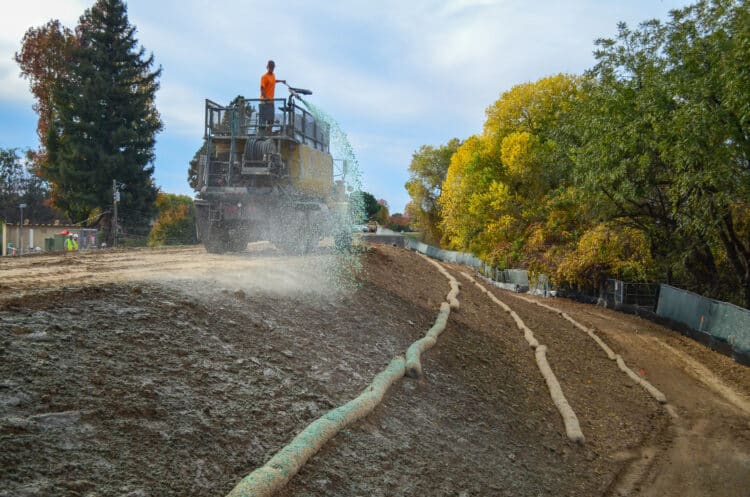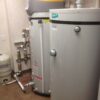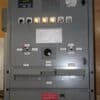
What is hydroseeding? Everything you need to know
What is hydroseeding? Are you curious about how this works? Soon, all your questions will be answered, so read on.
If you are a new homeowner with a bare spot of land in front or at the back of your house, you want to have a new lawn as quickly as possible. Hydroseeding might be your best option yet.
This process even works in bringing new life to your dying lawn. It may have undergone a very hot summer period where all of your plants have died or close to dying. If you think you have lost all hope and cannot save your lawn anymore, hydroseeding can still fix it.
It is a complicated subject matter and cannot be understood immediately. So buckle up and get ready to be transported to the delightful world of hydroseeding!
Table of Contents
A brief history
It is known by another name: hydromulching. It was developed in the 1940s by Maurice Mandel. He had previously worked at the Connecticut Highway Department in the United States of America.
He wanted to find a way to prevent soil erosion from happening after construction work was done on the places around the Connecticut roadways. After much experimentation, he decided on mixing water and seed and spray it on those areas.
Soon, it became a technical procedure that needs to be thoroughly learned and mastered. Later in 1953, Charles Finn perfected Maurice’s initial idea and cooked up the first hydromulcher. He founded the Finn Corporation and became the biggest and most prominent manufacturer of hydroseeders.
What is hydroseeding?
Little by little, you will begin to know what it is.
In concept, it is a way of seed-planting by spraying a mixture of seed, water, fertilizer, mulch, and other soil improvers on developed soil. It is the most effective manner of spreading any type of seed over a piece of a landmass.
In plain words, it is the cheapest, efficient, and best quality means of sowing a lawn. In turn, it halts the soil from eroding and makes the germination of seeds become faster.
If you use other methods, the lawn will typically sprout up in two to three weeks. With lawn hydroseeding, you will see growth in one to two weeks.
This procedure is also used in other plants, like oats and wildflowers. They follow the same mixture of water and other additives and spray it over an area.
To get the best out of this hydromulching system, there must be essential factors present:
- Fertilizer
- Good contact between soil and seed
- Seed protection
- Liquid retention
If you want the hydroseed to work in your lawn, you should first examine the soil content and find out the additives needed to make the plants grow better. You need to prepare the soil until it becomes receptive. So you have to loosen it up and remove its compactness. This way, the roots can safely grow underground.
After checking on the stability of your soil, find the right mixture of seeds that you want to plant (it also works with seeds other than grass).
Choose the appropriate fertilizer, improvers (aluminum sulfate, sulfur, nitrogen, iron sulfate, etc.), tackifiers (this is used for seeding in steep areas), mulch, and water. Then mix them all up, and you can spray them on your preferred soil space.
Its common uses
- Lawn beautification
- Stops the growing of weeds
- Keeps erosions from occurring in the soil
- Preventing the pollution dust from occurring
- Aids in the creation of public parks and sports areas like soccer fields
It is crucial in preventing soil erosion
From what you already know, doing hydroseeding yourself is an accomplishable task. However, knowing how is different from actually executing it. So there are yet many things more you need to learn about this intricate process.
This method has become a vital procedure after any large construction projects like bridgework, mining, or road layout. It is also done in the preservation of waterways to halt runoff from occurring.
It is a widespread technique even utilized by mining facilities. When the time comes when they cease operation, they hydro-mulch the entire area so that it can get back to its original and natural state.
If you see massive areas where any large establishment is about to be erected, you will observe hydroseeding equipment nearly. It is there to do the task after the work is finished, which will prevent the ground from wearing away because of rain and wind.
Its standard procedure to hydro-mulch after golf courses and large parks are created. Construction companies do this because it can be done quickly, cheaply, and efficiently.
How much does hydromulch cost?
Hydroseeding cost in the US is about eighteen cents per square foot. Since this procedure is often utilized in larger areas, like in massive space five thousand to ten thousand square feet, the pricing would be from nine hundred dollars to one thousand eight hundred dollars.
The costing would already include everything from the hydroseed installation, the preparation of soil and lawn, and the materials involved. The costs may vary from one construction site to another, so if you want to have this type of service, it is better to research it first.
If you are an avid DIYer and like to enact this method on your front yard, there are inexpensive hydro grass sprays available in hardware stores. Yet, for this delicate procedure, it would still be best to hire a professional.
The downside for using store-bought mixture, however cheap it may be, would not bring forth the same quality as with professional hydroseeders. It is also a strenuous task if you do it yourself because it will challenge you physically. It will take you more than six hours to do it correctly and finish it.
Can you hydroseed your lawn or any smaller space?
It would not be efficient if you plan to hydroseed a relatively small space like your lawn. This technique and equipment used are specially designed for massive areas.
Since the preparation of the soil is an essential step in the process, why not spend that time spreading seeds with the aid of a mechanical spreader?
After that, you can cover the whole area with hay to keep it away from birds and keep it from drying. Then your job is done, and you would not need hydro-mulch anymore.
Instead of utilizing commercial hydroseeding for your lawn, why not set up sod? You would not need to wait for seed germination to happen anymore, and you get your yard immediately.
However, there are disadvantages to sod. For one, it is more expensive, and the price to install it is one to two dollars per square foot.
Another, their variety for good lawn grass is very limited and is difficult to establish a healthy system of roots for it.
It would not be surprising if the cost of sod will be more than twice the price of hydroseeding.
However, the advantages of hydroseeding are many. For one, you have the option of selecting your preferred species and grass mixture that you want for your yard.
If you plant seeds directly to the soil instead of just installing sod, the roots would cling deep to the ground and establish healthy and strong plants. You also have to maintain it by constant watering and fertilizing.
When should you hydroseed?
The best time to do native hydroseeding will be dependent on your weather. The perfect time to do it is when the weather is cooler but not freezing. Also, another good time is right before it is about to rain when dark clouds are beginning to form.
Since it will rain, you do not need to water the area anymore. In places where there are four seasons, the best times are autumn and spring.
In both times, moisture is abundant with a relatively cool climate, the best conditions for seeds to spring up in healthy means.
The lawn will have the capability to become stronger, with a more stable root system before the winter or summer starts.
Your yard will become dormant when the winter season arrives. When it is over, it will begin to grow with the help of rain and the coolness of spring.
Hydroseeding in spring is perhaps the best time. There are spring rains, and the climate is cool, which would be greatly beneficial.
Spring’s disadvantage is that the following climate in summer. To compensate for the heat, you would spend a lot of time watering your hydromulched land to keep it alive and kicking.
Different types
The many advantageous things about hydromulching are that it is capable of becoming different types of slurries. You can choose from many seeds in their mixtures.
There are options where you can have plants that catch the eye or another kind that looks good in shady locations. There are wildflower mixtures that you can spray on an area that is difficult for lawn mowing.
Before doing the process of hydroseeding, you have to be sure that you are aware of the area that you live in because some seed types do not grow in particular climate conditions.
You can even choose the color varieties of the dyes used in the slurry since some companies tend to use it along with their mixtures. The largest quality of difference among the slurries, besides the kind of seeds used, is the type of mulch included.
Why do you think that mulch is essential in a hydroseeding mixture?
It is a significant component in making a slurry possible. When mulch is added with water (along with the other ingredients), since it is heavy, it enables the slurry to spray further and more effectively.
Mulch is significant because it assists in the proper growth of the seeds. Once mulch hits the ground, it serves as a safety coating over the pants, which will hold them together.
It gives protection from the numerous outside elements and encourages the germination of seeds. This mulch coating is the reason why it is utilized as a preventive measure for soil erosion.
Here are the kinds of mulch typically added in a slurry:
- Paper mulch- It is seldom utilized by hydroseeding companies and is not encouraged.
- Wood Fiber mulch- It is the most effective and most utilized. It is also the most expensive, yet it is still the best because it has more density and offers more coverage to the seeds.
- Blended mulch- It is generally a mixture of seventy percent wood and thirty percent paper. The best thing about this is because it is cheaper than the wood fiber mulch.
Some hydroseed seed mixes even include sawdust, man-made fibers to make the slurry work better.
Why choose hydroseeding?
There are other methods for installing a particular lawn, like grass seed and sod. To know what way is applicable for your area, you must know the others.
Sod
If you prefer this option, get ready to spend a great deal of money, since it is expensive to buy and install it. However, it is comparatively easy to set up because all you have to do is unroll it on the ground and constantly water it.
You can also set it up any time of the year and do not need to wait for a particular season. Just as long as you a good soil, you can have it on your lawn immediately.
However, it has the capability of bringing in plant diseases in your lawn space. Also, if you have unsuitable soil in your lawn, it can be difficult to establish a system where the grassroots can grow healthily.
Grass seeds
Some homeowners prefer this because it is the least expensive choice. It is relatively easy to set up like sod, but the growth rate is akin to a snail’s pace and can take many months.
You also have to always maintain it like constant watering and keeping wind and birds away from it from potentially displacing them.
Compared to the others, hydroseeding can trump both. However, as mentioned, it only works efficiently in very large areas. So your small front yard lawn might only benefit from the two other options.
How to hydroseed, DIY style
Maybe you want to give hydroseeding a try on your own and would greatly benefit you and your smaller yard since it is mostly utilized for larger areas only.
You can purchase all of the components in your neighborhood hardware store. It usually comes in a hydroseeding kit, which includes the seed concoction and the required tools. The most important element for this is the spray canister. Yet, there is also a way for you to create your mixture.
From what you have already learned, there are different kinds of hydroseeding mixtures. However, for your DIY concoction to work, you have to base it on your specific location because some of the ingredients might not work in a particular weather climate.
For example, in the Midwestern part of the United States, bluegrass is usually utilized because it is compatible with the environment.
Your DIY equipment will consist of a tank and a pump (you can use your garden hose for this) to spray the concoction to the area. You can also research other great ideas for a DIY sprayer.
If you cannot get a hold of any equipment for this venture, you can rent one from the hardware store. The cost for this will be around three hundred dollars per day.
You may think the task is over after you have sprayed the concoction to your yard, but it is not. You will still need to watch over your yard.
You have to keep it wet and constantly water it maybe three times a day, so that it would not get dry. This task would be easier when you do it in spring when the weather is cool, and the ground would take a long time to dry out.
So, as a responsible and avid DIYer, research is key. Find the best seeds that are compatible with your area, get the right equipment, and spray them on your lawn in cooler weather.
Steps in hydoseeding, DIY style
If you still want to hydroseed on your own, then follow these steps:
- Make tests on your soil. Take a small quantity of soil in your lawn to check on its PH levels. Based on the expert studies, lawn grass must have soil PH between 5.8 and 7.2. Grass that grows in warm weather needs a lower PH level, and grass that develops in cooler climates needs a higher PH.
Again research is the key to this first step. Find a facility that can do a test on your soil, which would incur a fee of around twenty-five to fifty dollars. - Take measurements on the entire area of your yard so that you will know how much of the hydroseed concoction you will have to make.
- You have to make your soil suitable for the hydroseeding supplies to fulfill its role. You have to loosen up at least three inches of the soil and take out its compactness.
- Be sure to buy all the necessary hydroseed supplies. Research for a local expert to apprise you on your necessary materials and the quantity required based on the largeness of your yard.
Choose the type of seed concoction that you want and be sure it is compatible with your climate.
Pick your preferred fertilizer that can abide with the seed concoction and lawn soil. Also, choose the additives needed to reach the PH level required from the soil testing. - look for an establishment that rents out a hydroseeder. Some can take in the concoction and mix it on their own, using “jet agitation” or “mechanical agitation.” You can use either equipment.
You should also be aware that “jet agitation” works for a small tank, which may fit with your small lawn. But “mechanical agitation,” although utilized got bigger areas, have the disposition to mix the ingredients tremendously. - Bring all the equipment and materials back to your lawn. Be sure to follow the advice from the expert you have consulted and the equipment instructions. Do not scrimp on the ingredients and start the mixing process. Make sure it is completely mixed, with the right balance and consistency.
- Start spraying the mixture. Do not be scant, and make sure you have coated the entire lawn area. Put all the money you have spent on this to good use and do not cut corners. Or else you might end up with a patchy lawn because you have not coated every portion.
- Once you are certain you have blanketed the entire area, wash the equipment clean and return it.
- As mentioned, keep the lawn watered at all times, at least three times a day. If you have followed all the instructions correctly, you will notice grass appearing on your lawn in one week.
Picking the right seeds
The purpose of selecting the right seeds for your lawn is because you have to find the right seed blend. You have to find something that will be compatible with the soil and has the color and feels that you may prefer.
Manufacturers for grass seeds create seed-types that are area-specific. For example, there are seeds developed for shaded locations and sunny places. Some are made especially for clay or sand, or even dry or wet soil, etc.
Select the seeds that are amenable to your soil, climate, and personal disposition. Maybe you leave home a lot and would not have time to water your lawn. So for this instance, choose seeds that require less water.
Here are the common grass types:
- Centipede grass- Preferred in the warm areas in the southern part in the USA.
- Bentgrass- It is the kind of grass utilized in golf courses in the northern USA.
- Zoysia- It is used in the middle part of the USA and in North and South Carolina.
- Fine Fescue- It is typical for shaded areas but will not grow on hot climates.
- Bermuda- This is the most popular grass breed and mostly used in gold courses in southern USA.
- Kentucky bluegrass- It is common grass in the northern part of the USA, but would not grow in shaded areas.
- Ryegrass- This breed would grow well in cooler areas in northern USA.
- Tall Fescue- It would work in cool weather and can still grow in hot climate.
Fertilizer
The fertilizer will work well if you know the kind of soil that you have on your lawn (you already know this from the earlier soil sample you have taken and tested).
Here are the three portions of a great fertilizer mixture:
- Potash- It can aid in preventing plant diseases.
- Nitrogen- It helps in the keeping the grass have a healthy green color.
- Potassium- It assists in the development of healthy grassroots.
Be sure that the fertilizer that you intend to add to your slurry mixture has these three components.
Tackifier
It acts as the glue that keeps the hydroseed slurry in place and sloped areas. Here are its different kinds:
- PAM (polyacrylamide)- It is a man-made substance that looks and feels like sand. It is a relatively cheap ad you can use about five pounds in one acre of land.
- GUAR (polysaccharide)- It has the texture of powder but is organic. It is more expensive than PAM and will take about sixty pounds of it to be included in the slurry to spread on one acre of land. It is suited for rainy areas.
- Other types: cross-linkers, liquids, and fibers.
Other soil improvers
Lime is utilized to increase the PH of acidic soil. Sulfur is added to lower the PH. The gel holds the moisture together in the soil.


